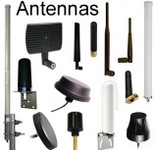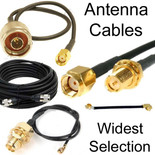Antennas, Antenna Cables, Wireless Products: Technical Articles
LTE Cellular Data Connectivity for Digital Signage

LTE Cellular Data Connectivity for Digital Signage
Advantages of LTE cellular connectivity for digital signage:
- Media content providers can use a performance LTE router to provide the necessary data service for primary connectivity for interactive digital signs. LTE is advantageous because the cellular connection means that signage can be rapidly deployed anywhere and for any duration.
- LTE can also be used as a back-up for existing WiFi or Ethernet-based connectivity.
- LTE can often be used in areas where WiFi performance is poor.
- No wires are needed, units are independent of landline connections.
- Uptime is maximized which is vital for honoring Service Level Agreements of the media content provider.
- End-user LTE routers that have been developed for this purpose are easy to set up and manage.
- Central management of the media equipment and devices remotely reduces the time and expense of personnel in the field.
- LTE uses the cellular network, coverage is good and a persistent and reliable connection can be maintained. This is vital for unmanned installations.
- Harnessing the cellular network means that hundreds of locations can benefit from a synchronized cellular connection.
LTE routers deliver LTE connectivity to contemporary digital signage systems.
Cloud-based dynamic display systems use LTE routers to update their digital signage content. These routers are driven by a powerful cellular modem that can provide LTE internet connectivity and distribute it via WiFi, Ethernet, or USB.
Industrial cellular routers supply the internet connection that facilitates the transfer of new media updates from the CMS via its Digital Output (DO). The media player needs to check the content management server for new content at regular intervals.
This connectivity allows advertisers to keep the displayed media up to date. The LTE connection can also be used by personnel to undertake remote maintenance tasks for the network. Some cellular routers for digital signage are capable of triggering a hard reset to reboot the system, reducing the costs of disparate site visits and maximizing system uptime.
Example technical specifications for LTE routers for digital signage
LTE routers can be built or purchased out-of-the-box for plug-and-play LTE connectivity. The specifications of these routers span Low Power Wide Area Networking connectivity that is suitable for IoT, to high-category LTE that can support high definition multimedia content. For the routers to be authenticated by a cellular network a SIM card (or dual SIM) is required.
LTE User Equipment (UE) Categories specify the LTE speeds that can be delivered by the cellular modem in the router. Most commercial units provide low-category and higher category connectivity. For example:
- Category 6 LTE has a downlink data rate of 300 Mbps and an uplink data rate of 50 Mbps
- Category 4 LTE has a downlink data rate of 150 Mbps and an uplink data rate of 50 Mbps
- LTE-M has a downlink data rate of 300 Mbps and an uplink data rate of 375 Mbps
- LTE-NB has a downlink data rate of 27 Mbps and an uplink data rate of 65 Mbps
LTE M and LTE NB are versions of LTE that have been developed for M2M and IoT networking. Inbound and outbound communications via the LTE module are secured with remote authentication, inbound and outbound port filtering, and trusted IPs. External antennas are attached to the router via SMA connectors, which are typically used for cellular applications, more on this below.
Depending on the router design, they also carry a WiFi radio. The highest specification LTE routers will offer 802.11ac Wave 2 WiFi that operates at 2.4 GHz and 5 GHz and can support up to 10 client devices. The WiFi networking component is secured by WPA2 Enterprise which delivers enterprise-level security. All booting and firmware updates are secured end-to-end.
Interfaces carried by commercial routers include:
- Recommended Standard or RS 485: this is a standard produced by the Telecommunications Industry Association (TIA) that specifies the electrical connection for devices that have point-to-point connectivity. It is widely used in automation protocols and systems.
- Ethernet ports: are used to deliver wired 802.3ab connectivity. Contemporary routers will use Gigabit Ethernet, whichhas data rates of up to 1 Gigabit per second. Ethernet ports may also be equipped to deliverPower over Ethernet (PoE) which is an advantageous power solution that removes the requirement of additional power cabling.
- USB 2.0 is a high-speed USB port.
- Analog and digital I/O: provide additional programming functionality for fully customizing a digital signage solution.
These units are typically built to be rugged with IP-rated polycarbonate electronics enclosures that are suitable for outdoor installation. They are kept compact to keep them discrete and easy to deploy.
Alternatively, an LTE digital media player is an all-in-one solution for connected digital signage.
An LTE media player combines a media player with the LTE connectivity needed to deliver content from a cloud server. This unit also allows content to be centrally controlled from a remote location and has the performance and reliability to run highly engaging campaigns. Many models also have an integrated LED display system. These units are similar in construction to commercial LTE routers with a low-profile design that can be installed discreetly.
Video screening encoders can harness high-throughput LTE (up to Category 10) to support 4K/60Hz image resolution. Units also carry WiFi and GPS. Multiple HDMI outputs allow more than one display to be connected to the media player. Most units also have Ethernet connectivity with RJ45 jacks installed.

Antennas for LTE digital signage
Commercial LTE routers and LTE media players require the attachment of external antennas to function. Up to three distinct types of antennas are needed to deliver the full functionality of these cellular networking devices depending on the specifications of the router or media player.
Antennas are typically connected via SMA bulkhead connectors fitted in the device casing and connected to the relevant radio cards via a U.FL or MHF4 connector.
Commercial LTE routers and LTE media players typically carry the following antennas:
- Two LTE monopole or dipole wideband antennas: LTE is used multiple-input and multiple-output, or MIMO to increase the throughput and capacity of a data connection. Most of these compact units carry two LTE antenna connectors, labeled MAIN and DIV or AUX. This is because the MIMO functionality of the antennas requires at least two antennas to create a 2x2 MIMO arrangement that has 2 data streams. This strategy almost doubles the throughput and speed of the LTE connection and makes it more resilient against interference.
- Monopole or dipole Wi-Fi antenna: If a cellular system offers WiFi connectivity, a suitable WiFi antenna is required to broadcast the connection to client devices. The use of the 802.11ac protocol requires a dual band antenna that can operate at both 2.4 GHz and 5 GHz.
- GPS antenna: A GNSS connection can be used to support location services that are advantageous in managing a network of media display units, especially if they are mobile.
LTE extends the functionality of digital signage technology.
LTE networking provides the data throughput that has allowed the technologies and applications used for digital signage to become markedly broadened.
A notable example of this is the use of biometric technologywhich tracks body heat and gaze to qualify and map interactions with the digital media that is displayed. When coupled with data management software, the engagement and effectiveness of campaigns can be evaluated with real-time adjustments where necessary.
LTE can support advancements in media display technologies including:
- Organic Light-Emitting Diode (OLED) is being hailed as the future of customer display technology. It uses novel carbon-based materials that will emit light if an electrical current is passed through them. It does not require backlighting and filtering needed by the standard LED and LCDs meaning that OLED screens can be incredibly thin and even bent. It is also very versatile with vibrant colors and brightness. As its costs fall, its adoption is rapidly increasing.
- Ultra High Definition (UHD) is a performance screen resolution that exceeds High Definition (HD). Its pixel count of 3840 by 2160 is almost four times that of HD. It is widely used for commercial digital displays.
- 4K is a screen resolution where the horizontal pixel count is approximately four thousand. It was originally developed by the Digital Cinemas Initiatives (DCI), an industry consortium that standardized this resolution for the production and projection of digital images.
Digital signage is a type of electronic signage that uses LED,LCD, or other types of display to present digital media for mass consumption in public spaces. They can display high-resolution images, videos and have integrated audio.
Digital content is well known for its efficacy as an advertising medium, drawing large numbers of viewers to large-scale displays that feature both moving and static images that have been proven to have an impact and foster interest. Over time, digital signage has become increasingly interactive, with the integration of audiovisual technologies like augmented reality and touchscreens necessitating high speed and high throughput data transfer.
Ongoing high-growth is expected in the digital signage sector.
Digital signage is also a high-growth sector. In 2018 it was estimated by the IHS Market Digital Signage Industry Market Tracker to have a global value of at least USD 18.55 billion, with projected growth to over USD 30 billion by the mid-2020s.
Digital signage has a variety of formats and applications:
These multimedia displays come in a variety of sizes and formats and are located in areas of prominence and high public footfall. The settings where digital signage is found are diverse including malls and retail businesses, public thoroughfares, stadiums, freeways, and hospitality or corporate buildings.
Digital content relayed via this technology can be advertising, transportation, or health information, or even personalized digital content.
Key components of a digital signage system
A functional digital signage system requires the following elements:
- Hardware: includes the physical components used in a system including screens, stands and mounting equipment, media players, routers, and networking equipment.
- Software: firmware is needed for the system devices and components as well as the content management system used.
- Networking:a digital signage system requires wired or wireless connectivity between its content management system and the digital display.
- Content: Digital media must be continually created or purchased to keep the signage relevant and engaging.
Centralized management of digital signage installation requires reliable connectivity.
Digital signage is typically centrally networked for the management of campaigns. This requires a networking solution that can connect all the display terminals, program and synchronize the displayed information.
Earlier digital signage formats used were reliant on wired connections, along with their associated costs and maintenance needs. Modern digital signage solutions largely rely on wireless networking for greater centralization, high-data consumption, and more precise remote management.
The growth and scale of the digital signage sector have even outstripped the utility of Wi-Fi as a primary form of connectivity. Aside from the compatibility of the software and hardware used for digital signage, networking is one of the critical hurdles affecting the growth of this sector. High-speed, high-throughput LTE connectivity is now emerging as the networking solution for streaming high-definition audiovisual content for signage.
LTE for digital signage solutions:
Long Term Evolution or LTE is a cellular networking technology developed by the Third Generation Partnership Project (3GPP). It uses cellular networking infrastructure and communication standards that are capable of facilitating a longer-term trajectory of upgrade and development, through 4G and 5G. Though LTE is distinct from 4G it shares several features including high-speed data transfer which is harnessed for the networking needed for responsive digital signage. It can perform the role of a cable, connecting the digital sign to the central database and relevant field assets.
In conclusion
LTE has differentiated itself as an excellent partner to a broad range of digital signage solutions. Its high-speed and high-throughput performance is ideal for cloud-based content management, live streaming, and high-resolution media that are the future of the digital signage sector.
The use of cellular networking bypasses many of the teething problems encountered with WiFi and wired connectivity, meaning that LTE is likely to emerge as the industry standard for digital signage connectivity.







